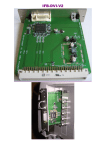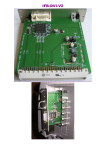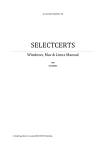Download Barco BG-DVI english user manual
Transcript
BG-DVI Installation and users Manual BG-DVI DVI-D Interface (HDCP) for Barco Video Projectors User manual for the BG-DVI interface (converts DVI-D to RGBHV). This module transforms the analogue video entry « PORT3 » of a Barco projector (BG800/801, BD808, BG808x, BG1208 or BG1209) to digital entry using DVI-D (HDCP compatible) standard. 1. Spécifications : • DVI-D input (100% digital). A HDMI to DVI-D cable can allow using it with a HDMI source • Compatible with the sources delivering digital signals either non-HDCP or HDCP • RGB 4:4:4 (8 bits) digital input format • Transforms the RGBHV (not the TTL) « Port 3 » to digital entry. • Triple video DAC: 10 bits 175MHZ. Inter-DAC Precision: 2% • RGB analog video outputs 0,7Vpp on 75 ohms • Minimal video path analogue distance (<2 cm) for an optimum picture quality • Bandwidth DVI in RGB out: 25-165MHz • Maximum supported Resolutions: WUXGA 1920x1080, UXGA 1600x1200 @ 60HZ or SXGA 1280x1024 @ 85HZ • Compatible data processing (PC, Mac) and HDTV (480p/576p/720p/1080i/1080p50 or 60) • HDCP compatible with internal programed keys • Power Management : compatible with DVI and VESA DPMS • Low Standby mode current rating (3,5mA) • Maximum Consumption 0.4A under 5V (DVI @ 165MHZ) or 0.09A under 30V (COMM. port) • Green LED for digital active (when digital source is active) • Low cost solution, uses one main integrated circuit 2. Installation : • PLEASE NOTE : while unpacking this display interface please take good steps to avoid possible Electric Static Discharge. Before touching the BG-DVI, please touch the chassis of the projector first. • Warning! Due to a differance of position of the "Comm Port" and "port3" inputs between the 800/1-120x series and the 808 series ; this module is built with a specified pitch spacing between those two plugs. This pitch value is relevant to the projector reference number (38mm for 800 series and 40mm for 808 series). It is not possible to install the BG-DVI built for a 800/1-120x on an 808 series and vice versa. • Follow the steps in order (example using Barco BG808 a projector): BG-DVI Locate the two inputs marked "COMM PORT" and "PORT 3" on the projector back panel Position the BG-DVI in order to connect the two connectors into each other. Male to female, female to male. BG-DVI Push the unit into place on the projector plugs Use a flat terminal screwdriver, screw the two external screws of the BG-DVI onto the corresponding plugs 4-40 locks of the projector. Make this with care since screws are quite tricky to get screwed because of the lack of mechanical guides inside the plactic cabinet. Do not miss the screws inside module cabinet ! BG-DVI Connect the DVI-D cable to the unit and screw on its two locks. Well to check that the weight of the DVI cord does not mechanically constrain the module. To reassure the path of the DVI cord by necklaces to prevent it from slip and to twist or tilt unit from the projector plugs • On the other end, connect the cable DVI-D to the DVD player or to the video processor with a digital video output (DVI or HDMI). • To power-up the DVD player or the video processor. • To power-up the CRT projector and select the « Port 3 » video input. The green led of the BG-DVI interface (located to the right side of DVI plug) must light itself to indicate that the digital communication protocol well established with the interface. • The picture of the source must been displayed by the CRT projector. • The installation of the BG-DVI unit is now finished. BG-DVI 3. Notices : It is possible that some Barco CRT display be not able to deliver the necessary current to the needed by the unit (~90mA/30V) or that the 30V power from the COMM. Port be leaves. In this case, unmount the module from the back panel of the projecteur, unscrew the 4 screws of the plastic case and choose the second possibility of the unit powering : + 5V from DVI source. [ Default position: BG-DVI powered from the PORT COMM. BG-DVI powered from +5V provided by DVI source Scew back the four screws on the module cover to close it. Re-install it on the projector back panel. When the module is unused and when its digital link is switched off, the converter should then swith off itself and enter in a standby mode (low power consumption). This converter does not have any video adjustments (sharpness, gamma, colours, …). It realizes a direct and pure digital to analog video conversion. To make these picture adjustments, use the DVD player or video scaler parameter adjustments. This converter do not modify the digital transmitted synchronisations signals polarity. THe analog synchronisation outputs signal (SYNC_H et SYNC_V) will have the same polarity as these delivered by the digital source. BG-DVI 4. Recommandations : Most video resolutions are programmed in the device (720P, 1080I HDTV, PC,...) but owing to the limitation of the DDC memory size used by the module, some video configurations (specific resolutions) are absent and it is necessary to have specific software to program these special video resolutions (for example: 1080P48, 1080i72, … i.e. through Powerstrip). Any resolution is programmable, the BG-DVI remains synchrone. In the case of the usage of a Video utility (i.e. powerstrip) do not use a video resolution with a pixelclock above 165MHz. In the case of a digital cable of more of 8M of length or of low quality, avoid using a video mode possessing a clock pixel above 130MHz you might add artefacts to the picture (unstable pixels - sparkling). This convertor does not contain any servicable items but does have static electricity sensitive circuits. Take the correct precautions to handle it. Always use a competent service repair technician for repairs. Never connect this interface to anything other than a Barco projector. BG-DVI 5. Troubleshooting • Check that the green LED of the module is lit. If this is not the case: - Check that the DVI cable connection is working (well connected). - Configure the DVD player or the video processor to output digital (DVI or HDMI) and set it to the required resolution. - If the power supply method of unit was updated (see 2 previous pages), check that the digital source is able to deliver 400MA at 5V on its digital output (DVI or HDMI). - If the digital cable is longer than 8M, it is preferable to use a cable of good quality and the 30V power mode through the Barco COMM port. • If the projected picture presents pixels with random colors (sparkling noise) : - The digital cable is too long or of poor quality. - Reduce the working resolution (or reduce the pixelclock rate). • If the picture of the projecteur does not post itself correctly (no sync) : - Check that the projecteur is not configured for sync on the Green or composite signal (in this case change the sync mode to separated H/V mode) - Check that the working resolution chosen on the DVD player or the video processor is compatible with the projector video performances. - Reduce the working resolution (or reduce the pixelclock rate). • If the picture of the videoprojecteur does not post itself correctly (poorly centered picture) : - To correct the phase and/or the horizontal amplitude of the sweeping of the projecteur to replace the picture in the screen. - In the case of the using « powerstrip », modify the parameters of front porch and back porch to correct the position of the picture within the screen. • If the picture of the projecteur is fuzzy: - Reduce the working resolution (reduce the pixelclock rate). • If the picture of the source does not appear on the projector: - Check the output of the DVI or HDMI source is active. - Check that the « PORT 3 » input has been selected on the Barco - Check that the Green LED of the convertor is lit. This confirms that the digital signal is present and recognized by conversion unit. • Using 1080P (50 or 60HZ) : This video mode is close to the limit of the conversion circuit used. To be able to use it, it maybe necessary to reduce the parameters front porch and back porch so that the pixelclock rate delivered by the digital source does not surpass the 165MHZ bandwidth that the convertor can accept. Wish CRT projectors a longer life within digital video world ! ♦ Thank to Andy (MadMrH) from UK for his help on translating this document from french to english. Apologize for any remaining mistakes.





















